Community Forest Gardens: Case Studies Throughout the United States
By Katherine Favor, NCAT Agroforestry Specialist
Contents
Introduction: What are Forest Gardens?
Forest Gardens in the Northeast
Forest Gardens in the Southeast
Forest Gardens in the Tropical Southeast
Forest Gardens in the Midwest
Forest Gardens in the Southwest
Forest Gardens in the Pacific Northwest
Forest Gardens in California
References
Further Resources
Introduction: What Are Forest Gardens?
Agroforestry is the practice of intentionally incorporating trees into agricultural production systems, and it can take many forms. Forest gardens, also called food forests or multifunctional woody polycultures, are one type of agroforestry practice that consists of arranging trees and understory plants—a majority edible—in multiple vertical layers, in a way that imitates early-succession forests, with each plant layer spaced widely enough for adequate light to fall upon all layers. Forest gardens typically contain up to eight vertical layers of plants and fungi that are edible, medicinal, or otherwise useful to humans.
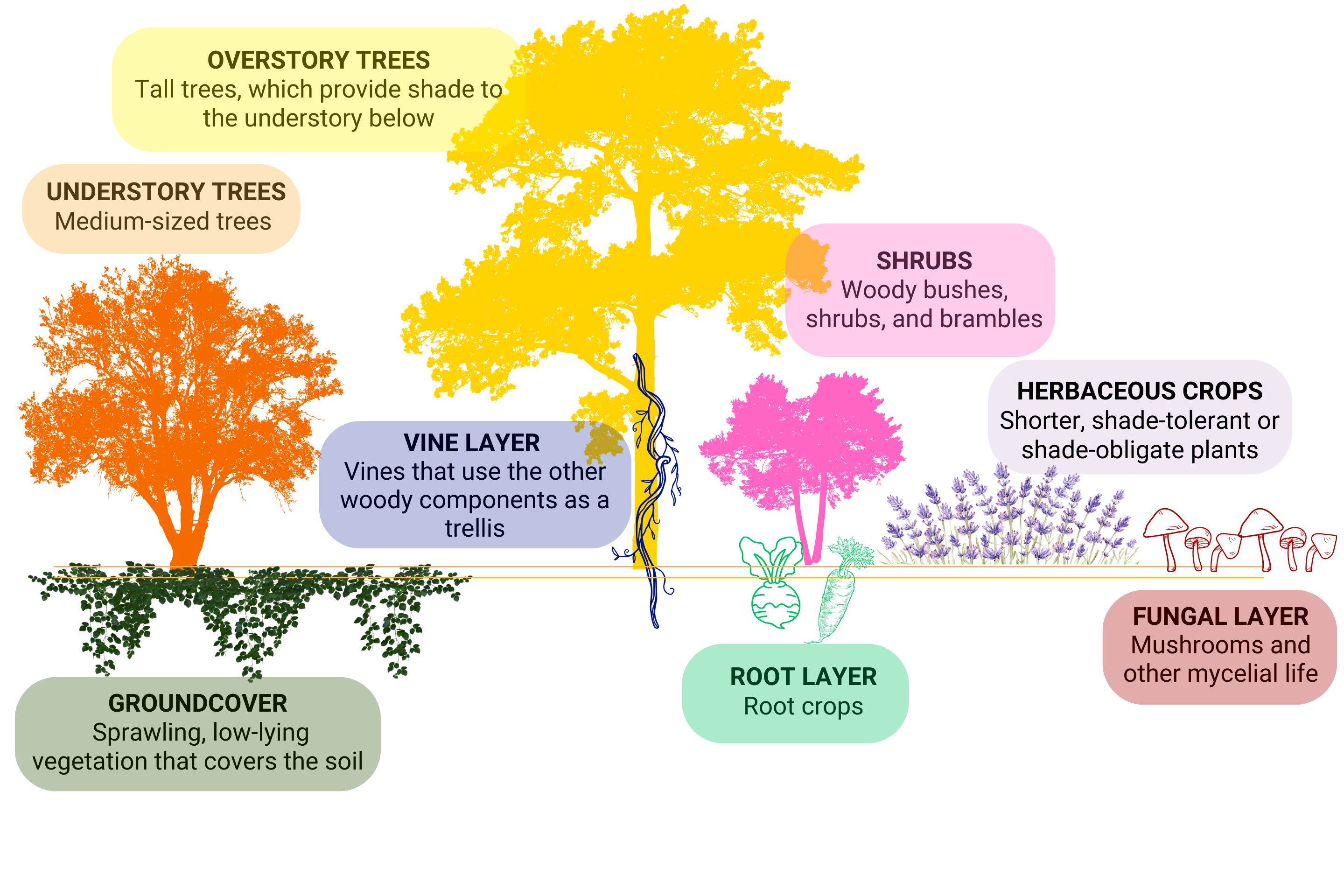
Forest gardens often contain up to eight vertical layers of plants and fungi, spaced widely enough so that some light reaches all layers. Graphic: Katherine Favor, NCAT
Plants in forest gardens can be selected not only for their ability to produce food and medicine, but also their ability to attract pollinators, provide habitat for wildlife, produce biomass, fix nitrogen for surrounding crops, serve as structural support for other plants, provide shade, improve soil health, and more. Because of their multiple layers of production, forest gardens can produce an abundance of food, medicinal species, and other useful plants in a small area.
Forest gardening is an ancient practice. Forest gardens have been part of Indigenous land stewardship for thousands of years and are still used today (Armstrong et al., 2022). Currently, forest gardens are also being integrated into cities, public parks, backyards, rural farms, schools, and numerous other spaces to feed families and communities, provide habitat for wildlife, offer a space for community members to gather, and provide other ecosystem services. This publication explores seven different community forest gardens throughout the country. While the growing contexts, goals, and species utilized in each of these forest gardens are different, the principles that guide them are similar.
Forest Gardens in the Northeast
Boston Food Forest Coalition, Boston, Massachusetts
USDA Plant Hardiness Zone 7a
The Boston Food Forest Coalition (BFFC) is a nonprofit community land trust run by and for the residents of Boston, with a mission to transform underutilized urban spaces into public food forests. To date, 10 food forests have been created in the Boston metropolitan area, thanks to the BFFC’s leadership and support from the City of Boston, community members, local organizations, and private foundations. Each of Boston’s 10 food forests was developed to foster climate resilience, racial equity, and community cohesion, and all decision-making and activities are centered around these three core pillars.
The Boston Food Forest Coalition consists of multiple components: a 501(c)(3) nonprofit, a community land trust, and 10 individual food forests. The food forests are the actual sites across the city that grow food, and they are stewarded and organized by members of the community. The nonprofit covers administrative tasks and provides a backbone of funding, insurance, access to utilities, a communications team, and an accounting team, so that the land stewards in each food forest are free to focus on growing food and hosting community events. The community land trust is a shared-equity agreement between the Boston Food Forest Coalition 501(c)(3) and local residents, and it holds land into perpetuity for shared use by community members. Together, these components form the Boston Food Forest Coalition. Orion Kriegman, BFFC’s Executive Director, explains that if BFFC were a tree, the nonprofit would be like the root system, stabilizing all endeavors, taking in resources, and distributing those resources to the other parts of the tree as needed. “The community land trust would be like the trunk of the tree, providing a solid foundation for each of the food forests,” he explains. “And the food forests themselves would be like the branches. The fruit – the fruit would be the people involved. That’s what this is all about.”
The process of converting vacant spaces into food forests is a grassroots endeavor that starts first and foremost with community interest. Typically, a group of neighbors who have a vision for growing food in their neighborhood will approach BFFC for help to turn their idea into a reality. BFFC then facilitates the process of land acquisition, in which city-owned land is put into BFFC’s community land trust. Much of the land in the BFFC community land trust thus far has been sold by the Boston Department of Neighborhood Development for a nominal fee. It was land that had been classified by the city as marginal land (land not suitable for other kinds of development for a variety of reasons) that the city had an incentive to sell. Transactions such as this are a win-win for both the city and the community: the city gets to relinquish responsibility for maintaining undevelopable land, while increasing community members’ land access. When this transaction is complete, the neighborhood collectively owns the land and takes on full responsibility of managing it. They have agency, power, and guaranteed permanence so that they can plant trees that they know will remain there for years to come.
After land is acquired, community members and local groups come together to set goals, plan, and implement their vision. The City of Boston has historically used community development block grant funds to cover some of the startup costs associated with implementation, paying for resources such as paths, irrigation infrastructure, signs, and trees. Other resources come from BFFC’s fundraising endeavors. When it comes time to plant, the community rallies together for what they call a “garden raising” day, named after the tradition of “barn raising,” in which people collectively cooperate to build something together. From then on, almost all maintenance tasks are taken on by community volunteers.
Because one of the goals of the Boston Food Forest Coalition is to build climate resilience, the nonprofit provides resources so each food forest can offer free and low-cost educational activities to teach community members about sustainable living practices. Workshop topics in the past have ranged from mushroom inoculation to regenerative design, compost tea production, tree pruning, and even timber framing. BFFC’s website also serves as an educational resource hub, providing dozens of free informational guides and videos on topics related to permaculture and agroforestry in the Northeast. Volunteer days are also ways for community members to “learn by doing.”
The Boston Food Forest Coalition has nurtured 10 food forests to date, but its long-term goal is to develop 30 food forests in the Boston area by 2030. BFFC hopes its model can not only serve Boston but also be an inspiration and a roadmap for other community agroforestry projects across the country.
What’s Growing?
Overstory Tree Layer: American chestnut (Castanea dentata), black cherry (Prunus serotina), black walnut (Juglans nigra), Chinquapin oak (Quercus muehlenbergii), ‘Qing’ Chinese chestnut (Castanea mollissima), common hackberry (Celtis occidentalis), Northern hardy pecan (Carya illinoinensis), red mulberry (Morus rubra), persimmon (Diospyros virginiana)
Understory Tree Layer: ‘Summerred’ apple (Malus domestica), ‘Moongold’ apricot (Prunus armeniaca), ‘Viking’ black chokeberry (Aronia melanocarpa), ‘Coral Burst’ crabapple (Malus spp.), American black elderberry (Sambucus canadensis), common fig (Ficus carica), nannyberry (Viburnum lentago), ‘Red Haven’ peach (Prunus persica), ‘Bartlett’ pear (Pyrus communis), ‘Singo’ Asian pear (Pyrus pyrifolia), Shadblow serviceberry (Amelanchier canadensis), Siberian pea-shrub (Caragana arborescens), staghorn sumac (Rhus typhina), ‘Stella’ sweet cherry (Prunus avium), ‘Evans Bali’ sour cherry (Prunus cerasus), Vernal witch hazel (Hamamelis virginiana), pawpaw (Asimina triloba)
Shrub Layer: American gooseberry (Ribes hirtellum), blackberry (Rubus allegheniensis), highbush blueberry (Vaccinium corymbosum), lyre-leaved sage (Salvia lyrata), Northern bayberry (Morella pensylvanica), raspberry (Rubus idaeus), sea buckthorn (Hippophae rhamnoides)
Herbaceous Crop Layer: ‘Alpha’ calendula (Calendula officinalis), asparagus (Asparagus officinalis), comfrey (Symphytum officinale), common mullein (Verbascum thapsus L.), common yarrow (Achillea millefolium), dill (Anethum graveolens), echinacea (Echinacea angustifolia), evening primrose (Oenothera biennis), giant zucchini (Cucurbita pepo), goldenrod (Solidago canadensis), kale (Brassica oleracea), lambsquarters (Chenopodium album), lemon balm (Melissa officinalis), Swiss chard (Beta vulgaris)
Groundcover Layer: mint (Mentha spicata), nasturtium (Tropaeolum majus), purslane (Portulaca oleracea), strawberry (Fragaria x ananassa), thyme (Thymus vulgaris)
Root Crop Layer: turnip (Brassica rapa), garlic (Allium sativum), onion (Allium cepa), beet (Beta vulgaris), carrot (Daucus carota), turnip (Brassica rapa), radish (Raphanus sativus)
Vine Crop Layer: ‘Concord’ grape (Vitis labrusca ‘Concord’), hardy kiwi (Actinidia arguta), maypop (Passiflora incarnata), sugar snap pea (Pisum sativum var. macrocarpon), ‘Golden jubilee’ heirloom tomato (Solanum lycopersicum)
Fungal Layer: shiitake mushrooms (Lentinula edodes)
Forest Gardens in the Southeast
Grow Enrichment at Two Rivers Park, Nashville, Tennessee
USDA Plant Hardiness Zone 7a
Tucked into Nashville’s 374-acre Two Rivers Regional Park lies a 14-acre agroforestry learning lab, stewarded by the nonprofit Grow Enrichment, in partnership with the Metro Nashville Parks Department. The entire site is a living, dynamic, outdoor classroom where nature-based learning and environmental education take place for children, teens, and adults alike. The space contains a food forest, a nature play area for children, an orchard silvopasture system with goats that graze the understory, a bee sanctuary, an aquaponics system, a pawpaw forest farming system, and an urban forest with walking trails to explore. It is the first community agroforestry system of its kind on public park land within the city of Nashville.
Co-founder and Executive Director Ginger-Rose Krueck explains that the idea for creating a community outdoor education garden came about after years of frustration at the lack of outdoor education in her own children’s schools. She had seen too many school gardens start and fail because of lack of support from parents and faculty, limitations around what kind of curriculum could be taught in the garden, and restrictions on who could access the space. She dreamed of creating an inclusive and accessible space where all children, teens, and adults—regardless of background, race, socioeconomic status, or age—could learn and play in nature. After years of trying out different ideas, she decided to form her own 501(c)(3) nonprofit called Grow Enrichment, and she approached the City of Nashville Parks and Recreation Department with the idea of creating an outdoor learning garden on public park land. The City offered several Parks Department plots that had been underutilized and in danger of development. In selecting a site from the choices she was offered, it was important for Ginger-Rose to find a site that could be: 1) fully accessible to the public at all times; 2) located near under-resourced schools, so that low-income children could access it; and 3) located along a public transportation route, so that those with transportation barriers could access it. In 2017, after years of searching, she finally found the right place at Two Rivers Regional Park in Nashville. The City agreed to provide the land to Grow Enrichment for free through a land-use permit that renews on an annual cycle, in exchange for Grow Enrichment’s promise to steward and care for the land. Grow Enrichment received the “keys” in 2018, and shortly afterwards, volunteers broke ground to establish various agroforestry systems.
Ecological Design
Grow Enrichment’s 14 acres boast a number of different agroforestry and other food-production systems, all of which function to produce food, foster connection with nature, provide habitat for wildlife, and serve as a backdrop for educational programming. Terraced along a slope leading down to Two Rivers Lake are the educational gardens, where a wide variety of vegetables and native medicinal plants are growing. The ecological design of these gardens incorporates several agroecological practices, including companion planting, composting, and mulching. The site also hosts “hügelkultur” infiltration basins, in which deep trenches are dug and filled with layers of whole logs, brush, straw, and compost. These hügelkultur infiltration basins have been dug in strategic locations along the contour lines of the park’s hillsides, in order to capture and retain water that flows down the slope. The hügelkultur basins have been so successful at water capture that the vegetables planted on the garden beds on top of the trenches don’t rely on irrigation. Nearby is a small forest garden, where multiple layers of edible plants like plums, rosemary, and strawberries are grown together in guilds (groupings of plants that complement and enhance each other). Practices like these enable food production while relying on as few inputs as possible.

An outdoor playground made of native tree logs is nestled under native forest overstory. This playground is designed to passively teach children how to identify native trees through their five senses. Photo: Katherine Favor, NCAT
The bulk of the food produced at Grow Enrichment comes from the organization’s silvopasture orchard. The trees in the orchard are hybrid chestnut, persimmon, sassafras, mulberry, and pecan, and the understory consists of native grasses that are rotationally grazed by Grow Enrichment’s herd of goats. This orchard was planted to be a successional system that will evolve as the trees grow over time. The alleys in the orchard are spaced 50’ apart to accommodate what will one day be a fully grown chestnut crown; however, in-row trees are spaced much closer, at just 6 feet apart, as the eventual plan is to thin the fruit trees and leave only the nut trees. In several years, when the orchard is producing more, Grow Enrichment plans on donating all the food produced from this space to a food bank that serves local schools.
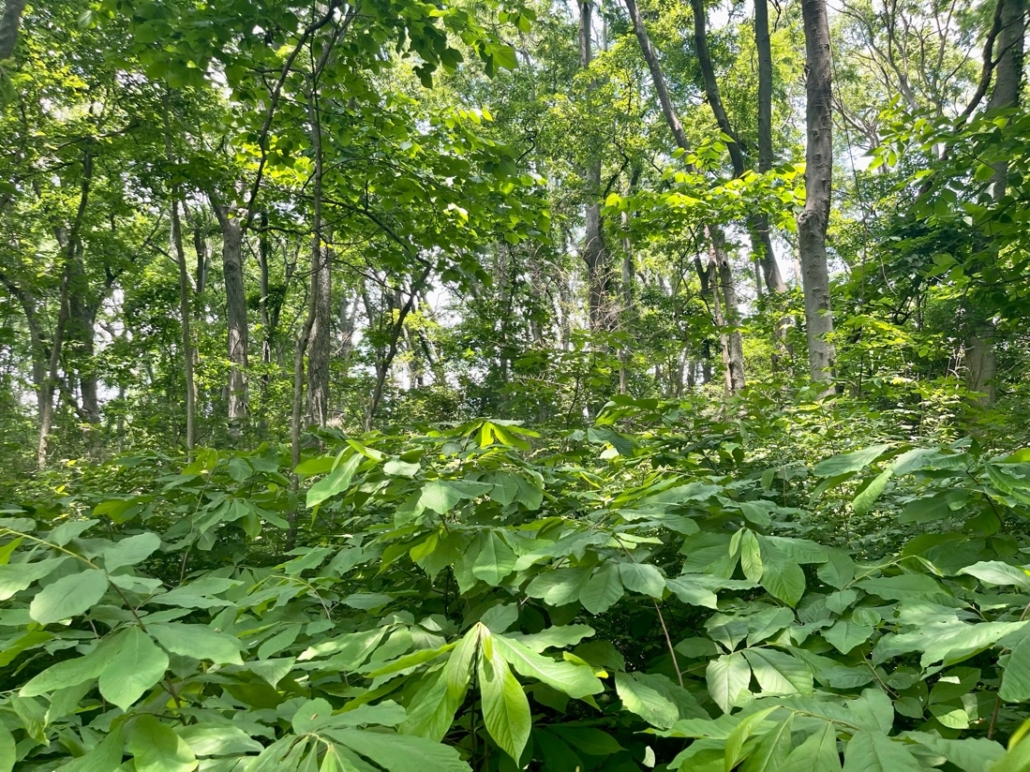
An overstory of native oak, hickory, and hackberry shelters an understory of edible pawpaw trees in Grow Enrichment’s urban forest at Two Rivers Park. Photo: Katherine Favor, NCAT
Grow Enrichment’s urban forest is in the process of being restored and transitioned into a forest farming system, as well. Before Grow Enrichment began stewarding it, this forest had been severely neglected for decades and was in danger of being overtaken completely by invasive plants like Chinese honeysuckle, Chinese privet, and Wintercreeper euonymus. Foresters estimated that if no remediation were done, within 20 years invasives would kill the majority of the native species like Northern red oak, Bur oak, poplar, hackberry, and hickory. To prevent this, Grow Enrichment is implementing a forest restoration plan, which involves picking up trash, removing invasive understory plants, and thinning out dead and dying trees to allow more light to reach the understory. So far, volunteers have clocked over 4,000 hours dedicated to this task alone, and in the future, Grow Enrichment also plans on using goats to control some of the invasives. Now, Grow Enrichment is taking this restoration one step further and is transforming a portion of the forest into a forest farming system, with an understory of mulberry and more than 1,000 native pawpaw trees. Grow Enrichment is also seeding native groundcover plants, including false strawberry (Potentilla indica), trillium (Trillium grandiflorum), mayapple (Podophyllum peltatum), and native ferns to control invasives.
Community Engagement
Grow Enrichment’s native forest and multiple agroforestry systems are the backbone of its outdoor classroom. These spaces were designed after Montessori philosophy that considers play as the foundation for learning, and which posits that nurturing sensory exploration leads to a natural pursuit of knowledge. Ginger-Rose explains that in the Montessori model, it is the teacher’s job to simply prepare a space for learning to happen and to allow children’s natural curiosity to guide them. “Children are going to learn independently if you prepare an educational space for them to explore,” she says. The entire 14 acres of Grow Enrichment’s site were designed intentionally to be that kind of space. For instance, tucked inside a clearing in Grow Enrichment’s forest, there is a playground surrounded by a fence made of whole native tree logs. While children play in this playground they are encouraged to touch the bark, which will help them learn to identify trees by touch from a young age. “Think about a three or four-year-old,” says Ginger-Rose. “They’re playing in this sand pit and they’re touching these posts, and they’re becoming familiar with the different types of bark – locust, oak, hackberry, cedar. So from a young age, they’re building intrinsic knowledge of the trees native to the place they live in. Then, on top of that foundational knowledge, we will start to build other knowledge about forests as they get older – we’ll start to teach about nomenclature, tree life cycles, and then the forest ecosystem as a whole.”

The educational garden overlooking Two Rivers Lake is planted on top of trenches filled with logs and branches that help slow down and store water from runoff. This practice, commonly referred to as hügelkultur, keeps soil moist year-round and allows the gardens to survive without relying on irrigation. Photo: Katherine Favor, NCAT
Within its spaces, Grow Enrichment hosts dozens of educational programs, including a bee husbandry internship for teens, an “Urban Ecology” homeschooling program, preschool, summer camps, and afterschool programs. It also partners with local schools, Girl Scout groups, and other community groups to facilitate field trips and workshops. Some of the educational activities for kids include making ladybug hotels, reading about urban wildlife together, facilitating nature journaling, building bat houses, leading nature hikes, observing butterflies at the Monarch hatching station, and of course, planting and harvesting food. All of the programs are offered at a minimal cost, and Grow Enrichment also offers some full scholarships for low-income children. Eventually it aspires to offer free lifetime scholarships to low-income children so they can receive continuous, ongoing outdoor education and programming. Grow Enrichment continues to seek private donor funding to make this happen.

Grow Enrichment’s silvopasture system includes hybrid chestnuts, mulberry, pecan, sassafras, and persimmons, and the understory is seasonally grazed by a herd of goats. Photo: Katherine Favor, NCAT
Other activities that are offered include volunteer days where people learn hands-on how to grow their own food. During these events, participants not only have permission to make mistakes, but their mistakes are embraced and are used as a learning opportunity. “So often volunteers want to learn but they feel afraid to make a mistake; they’re nervous,” explains Ginger-Rose. “But making mistakes is part of the learning process, and we actually encourage people to try new things here and to mess up.”
Although Grow Enrichment is growing a lot of food at its site, the organization sees itself more as a community development nonprofit than a production farm. “Our goal is to bring people together and to improve their quality of life,” says Ginger-Rose. “And we also want to give children meaningful experiences in nature that allow them to fall in love with it so that when they grow up, they want to protect it.” In the middle of Nashville, the educational programming that Grow Enrichment offers is sowing the seeds that will grow the next generation of environmental conservationists.
What’s Growing?
Overstory Tree Layer: ‘Celestial’ hybrid chestnut (Castanea dentata x mollissima), red mulberry (Morus rubra), tulip tree (Liriodendron tulipifera), American persimmon (Diospyros virginiana), sassafras (Sassafras albidum)
Understory Tree Layer: American elderberry (Sambucus nigra ssp. canadensis), American red plum (Prunus americana), dogwood (Cornus florida), pawpaw (Asimina triloba)
Shrub Layer: autumn sage (Salvia greggii), lavender (Lavandula angustifolia), ‘Heritage’ raspberry (Rubus idaeus), rosemary (Rosmarinus officinalis), witch hazel (Hamamelis virginiana L.), wild blackberry (Rubus occidentalis)
Herbaceous Crop Layer: ‘Katarina’ cabbage (Brassica oleracea Capitata group), ‘Champion’ collards (Brassica oleracea Acephala group), American marigold (Tagetes erecta), ‘Jarrahdale’ pumpkin (Cucurbita maxima), ‘Tennessee Red’ peanuts (Arachis hypogaea), heirloom cotton (Gossypium hirsutum), lyreleaf sage (Salvia lyrata), rosemary (Salvia rosmarinus), cosmos (Cosmos sulphureus), lettuce (Lactuca sativa), plantain (Plantago lanceolata), echinacea (Echinacea purpurea), peppermint (Mentha × piperita), chocolate mint (Mentha × piperita), iris (Iridaceae), common milkweed (Asclepias syriaca)
Groundcover Layer: ‘Sweet Charlie’ strawberry (Fragaria x ananassa), false strawberry (Potentilla indica), white clover (Trifolium repens), purslane (Portulaca oleracea)
Root Crop Layer: heirloom golden sweet potato (Ipomoea batatas), onion (Allium cepa L.), carrot (Daucus carota), radish (Raphanus sativus L.), beetroot (Beta vulgaris)
Vine Crop Layer: maypop (Passiflora incarnata), tomato (Solanum lycopersicum), muscadine grape (Vitis rotundifolia)
Fungal Layer: wine cap mushrooms (Stropharia rugosoannulata)
Forest Gardens in the Tropical Southeast
The Education Fund, Miami-Dade County School District, Miami, Florida
USDA Plant Hardiness Zone 11a
In the Miami-Dade County Public School District, food forests are a normal part of elementary school education, thanks to an initiative started by the nonprofit The Education Fund. Fueled by a shared commitment to student success, The Education Fund has supported more than 4,800 Miami-based projects over the years, one of which is an initiative called “Food Forests for Schools.” This program has installed school garden “eco labs” in 51 of Miami-Dade County’s elementary schools, 26 of which have evolved into perennial food forests. This initiative is the first and largest school food forest initiative in the county, serving more than 30,000 students in the Miami-Dade County Public School District to date.
Miami-Dade Public School District’s original school garden project started in 2007 with annual garden beds. However, without teachers and students present to water, weed, and protect plants during the summer months, many gardens died and had to be replanted from scratch at the start of each school year. Eddie Recinos, an art teacher at the time at Twin Lakes Elementary School, was determined to find a solution to this problem. Instead of throwing out the idea of school gardens completely, he wanted to figure out how to design a garden that would require less maintenance. He began learning about food forests and had the idea to integrate perennial trees and shrubs into the garden design in addition to annual plants. In 2013, the first Miami-Dade public school food forest was planted. Although food forests can be just as labor-intensive as annual gardens, the rhythm of maintenance that they require can be more in-line with the scheduled breaks that a school calendar follows. There are seasons of intensity, but there are also seasons where trees can be left alone, if the proper pest exclusions, irrigation systems, and other protections are in place. Eddie found that his pilot food forest was able to survive periods of neglect much better than the annual gardens did, so in 2014, The Education Fund decided to replicate his idea in other schools in the district.
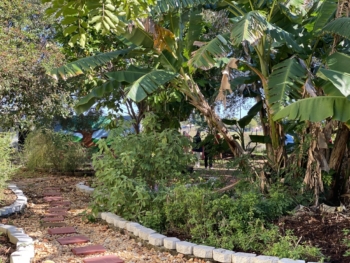
Photo: Debi La Belle, The Education Fund
Eddie eventually transitioned from being a teacher to being the full-time designer and Senior Program Manager for the Food Forests for Schools program. He meticulously designed each of the 26 school food forests with a different ecological composition to fit each school’s needs, resources, and growing context. In addition to hosting multiple layers of plants, these designs also incorporate outdoor classroom infrastructure with paved areas, tables, chalkboards, and other structures that facilitate learning activities, labs, and experiments. Today, Eddie and fellow Food Forests for Schools Program Manager Debi La Belle continue to steward the program and aid in the design of new school food forests.
All 26 food forests in the Food Forests for Schools program serve as dynamic outdoor learning classrooms where students learn about agriculture, nutrition, and the principles of ecology while experiencing firsthand the interconnectedness of the natural world. The daily maintenance of the food forests is performed mostly by teachers and students, who take ownership of the project and pride themselves on its beautification. Students participate in every aspect of the care of the food forests, from planting to tending to harvesting. Through these actions, they learn the skills for growing their own food and gain an understanding of the importance of environmental stewardship. Many maintenance tasks are woven into the school curriculum, as well. The Education Fund has developed 80 science modules and 40 math modules that can be taught in a food forest; all of which have been approved by the Miami-Dade County Public Schools Department of Curriculum. Curriculum topics range from weather patterns to planetary cycles, properties of matter, gravity, the human body, and many more. In addition to maintenance by students and teachers, The Education Fund has hired staff whose job is to do food forest maintenance, help harvest and distribute produce, and conduct lessons every few weeks. The Education Fund also contracts seasonal specialists for certain larger tasks that involve a specific skillset, such as tree trimming, irrigation repair, and landscaping.
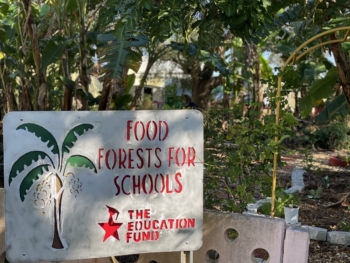
Photo: Debi La Belle, The Education Fund
Over the years, the Education Fund’s school food forests have evolved to be a powerful tool for not only cultivating environmental awareness, agricultural education, food system awareness, and plant science education in Miami-Dade County youth, but also for cultivating health. Beyond the educational benefits of these food forests, they also help to support food and nutritional security both during school hours and after school. Produce grown at the food forests is regularly incorporated into the school district’s lunch program. To date, more than 230,000 bags of produce have been taken home by students. By eating the organic, local produce that they themselves have grown, children may form healthy eating patterns from a young age, building a foundation for health as they grow older.
What’s Growing?
Overstory Tree Layer: June plum (Spondias dulcis), Guanabana (Annona muricata), custard apple (Annona squamosa), breadfruit (Artocarpus altilis), jackfruit (Artocarpus heterophyllus), bilimbi (Averrhoa bilimbi), star fruit (Averrhoa carambola), neem (Azadirachta indica), ackee (Blighia sapida), star apple (Chrysophyllum cainito), black sapote (Diospyros digyna), loquat (Eriobotrya japonica), ice cream bean (Inga edulis), mango (Mangifera indica), mulberry (Morus nigra), allspice (Pimenta dioica), mamey (Pouteria sapota), java apple (Syzygium samarangense), tamarind (Tamarindus indica)
Understory Tree Layer: papaya (Carica papaya), chaya (Cnidoscolus aconitifolius), Grumichama cherry (Eugenia brasiliensis), bay laurel (Laurus nobilis), Barbados cherry (Malpighia emarginata), banana (Musa spp.), plantain (Musa paradisiaca), cacao (Theobroma cacao), moringa (Moringa oleifera)
Shrub Layer: gooseberry (Ribes uva-crispa), sugar cane (Saccharum officinarum), pigeon pea (Cajanus cajan), Roselle (Hibiscus sabdariffa), Moujean tea (Nashia inaguensis), katuk (Sauropus androgynus)
Herbaceous Crop Layer: toothache plant (Acmella oleracea), garlic chives (Allium tuberosum), lemon verbena (Aloysia citrodora), galangal (Alpinia galanga), bok choy (Brassica rapa subsp. Chinensis), eddo (Colocasia antiquorum), cilantro (Coriandrum sativum), lemongrass (Cymbopogon citratus), cardamom (Elettaria cardamomum), arugula (Eruca sativa), Okinawa spinach (Gynura bicolor), longevity spinach (Gynura procumbens), Oaxacan lemon balm (Lippia alba), cassava (Manihot esculenta), African blue basil (Ocimum kilimandscharicum), Costa Rican mint (Satureja viminea), stevia (Stevia rebaudiana)
Groundcover Layer: ‘Sissoo’ spinach (Alternanthera sessilis ‘Sisso’), perennial peanut (Arachis glabrata), Malabar spinach (Basella alba), sweet potato (Ipomoea batatas), gotu kola (Centella asiatica), Seminole pumpkin (Cucurbita moschata), Cuban oregano (Coleus amboinicus)
Root Crop Layer: turmeric (Curcuma longa), ginger (Zingiber officinale)
Vine Crop Layer: butterfly pea (Clitoria ternatea), creeping cucumber (Melothria pendula), passion fruit (Passiflora edulis), winged bean (Psophocarpus tetragonolobus), chayote (Sechium edule)
Thank you to Laura McCoy, Alex Crow, Jennifer Perez, Érika Rocha Guimarães, the International Center for Tropical Botany at The Kampong (ICTB), The Florida International University Institute of Environment, and The Education Fund for providing this list of species.
Forest Gardens in the Midwest
Lawrence Community Orchard, Lawrence, Kansas
USDA Plant Hardiness Zone 6a
Sitting on an acre of public county land in Northeastern Kansas, Lawrence Community Orchard is an edible forest garden open to the public from sunrise to sunset every day. With more than 100 edible woody perennials, including 30 varieties of fruit and nut trees, this multi-strata orchard provides an abundance of food to the Lawrence community, offering visitors a space to learn, relax, harvest, and enjoy the space as they please.

Photo: Hannah Hemmelgarn, University of Missouri Center for Agroforestry
Lawrence Community Orchard project coordinator Skyler Adamson explains that the forest garden began in 2008 as a grassroots community initiative driven by the shared vision of residents who wanted to create a productive and accessible edible landscape in their town. What started as an informal group of neighbors planting fruit trees in their neighborhood later evolved into a 501(c)(3) nonprofit called Lawrence Fruit Tree Project. In 2012, Douglas County provided the project with a parcel of public park land through a program called Common Ground, in which land is leased at a very low cost to community members who want to garden or farm. This program currently provides land at 11 local urban agriculture sites, and Lawrence Community Orchard is one of them. The land where Lawrence Community Orchard sits is on a floodplain and is considered undevelopable by the County; because of this, the Lawrence Fruit Tree Project was given a zero-cost, three-year rolling lease that will automatically renew after its expiration. Other costs associated with care of the forest garden are covered by the nonprofit Sunrise Project, which serves as the fiscal sponsor to the Lawrence Fruit Tree Project, and there is also a donation box on site where visitors can donate to the project if they desire.
The maintenance and care of Lawrence Community Orchard is led by Skyler and is carried out almost entirely by volunteers. “Community garden projects like this do benefit from consistent management decisions, so it’s important to have at least one person committed in a bigger way, who can guide decision making,” explains Skyler. “But volunteers provide the majority of the labor.” Volunteers first attend an orientation, in which skills are taught and identified. Then they are encouraged to “adopt” a section of the forest and volunteer on their own time in that specific area, for that specific task. One to two times per month there are group volunteer days, as well. “The orchard is like a botanic garden, a learning orchard, and an experimental station all in one,” Skyler says. “We plant all different types of plants with the aim of seeing what thrives best here, and volunteers are encouraged to learn and try out new skillsets that they may have not been familiar with before.”
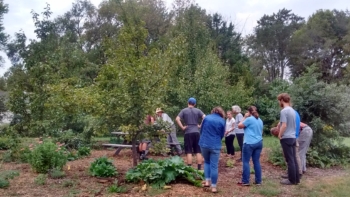
Photo: Hannah Hemmelgarn, University of Missouri Center for Agroforestry
When fruit is ripe and ready for harvest, project coordinators inform visitors by placing “it’s ripe” signs near the trees that can be harvested. They also communicate with visitors through Instagram, offering educational photos and videos that demonstrate best practices, such as how to identify different plants, how to determine ripeness, and how to properly harvest. In order to minimize the hazards associated with harvesting fruits and nuts from tall trees, the orchard provides picking poles, so that visitors can safely pick hard-to-reach fruit without climbing on trees or ladders. While harvesting is always encouraged, community guidelines do ask that visitors limit themselves to collecting 15 fruits each, so that the abundance can be shared by many.
Today, the nonprofit Lawrence Fruit Tree Project serves as both an inspiration and a consultant for other community orchards around Kansas. “This isn’t just a production orchard, it’s a demonstration orchard,” explains Skyler. “We wanted to create a community agriculture system that was viable, that we could showcase not only to individual homeowners but also to institutions and municipalities, to say, ‘Hey, we’ve done this, and it works, and we can help you do it, too.’” Because of Lawrence Community Orchard’s success, the City did take interest, and now, Lawrence Fruit Tree Project and the City of Lawrence Parks and Recreation Department’s Forestry Division have partnered to plant pest-resistant, low maintenance fruit trees and shrubs in four public parks. They also collaborated with the City Transit Planner to plan, design, and implement “mini forest gardens” next to bus stops and in other parts of Douglas County, particularly in marginalized areas where the population has been underserved previously. They hope that their model of perennial community agriculture can serve as an inspiration for other communities across the country. Skyler encourages people to start small by planting just a few disease-resistant trees before diversifying. “Plant something edible in your community, even if it’s simple, even if it’s just a few trees,” says Skyler. “Communities should be producing food, and perennials happen to be a lower-cost and lower-labor way to do that. But you don’t have to be attached to any particular methodology or design when it comes to planting. Just start small, and plant what you can, and the community will benefit.”
What’s Growing?
Overstory Tree Layer: Hybrid persimmon (Diospyros virginiana), common hackberry (Celtis occidentalis), Chinese toon (Toona sinensis), Mandarin melon berry (Cudrania tricuspidata), Eastern redcedar (Juniperus virginiana)
Understory Tree Layer: American hazelnut (Corylus americana), ‘Liberty’ apple (Malus domestica), ‘Brown Turkey’ fig (Ficus carica), pomegranate (Punica granatum), yellowhorn nut (Xanthoceras sorbifolium), goumi berry (Elaeagnus multiflora), common elderberry (Sambucus nigra), Kousa dogwood (Cornus kousa), European pear (Pyrus communis), ‘Shinko’ Asian pear (Pyrus pyrifolia), pawpaw (Asimina triloba), ‘Coco’ jujube (Ziziphus jujuba), nannyberry (Viburnum lentago), juneberry (Amelanchier), tart cherry (Prunus cerasus)
Shrub Layer: buttonbush (Cephalanthus occidentalis), Nanking cherry (Prunus tomentosa), autumn olive (Elaeagnus umbellata), ‘Carmine Jewel’ bush cherry (Prunus fruticosa x cerasus), chokecherry (Aronia melanocarpa), false indigo bush (Amorpha fruticosa), basket willow (Salix viminalis)
Herbaceous Crop Layer: mayapple (Podophyllum peltatum), swamp milkweed (Asclepias incarnata), rattlesnake master (Eryngium yuccifolium L.), yarrow (Achillea millefolium), okra (Abelmoschus esculentus), kale (Brassica oleracea), basil (Ocimum basilicum), ‘Tabasco’ chili (Capsicum frutescens), Swiss chard (Beta vulgaris subsp. vulgaris), flash hybrid collards (Brassica oleracea), stiff goldenrod (Solidago rigida), comfrey (Symphytum officinale), rhubarb (Rheum rhabarbarum), asparagus (Asparagus officinalis)
Groundcover Layer: cantaloupe (Cucumis melo), oregano (Origanum vulgare), creeping rosemary (Rosmarinus officinalis ‘Prostratus’), thyme (Thymus vulgaris), nasturtium (Tropaeolum majus), rose verbena (Glandularia canadensis), cucumber (Cucumis sativus)
Root Crop Layer: ‘Orazio’ fennel (Foeniculum vulgare), garlic (Allium sativum), onion (Allium cepa), beet (Beta vulgaris), carrot (Daucus carota), turnip (Brassica rapa), radish (Raphanus sativus)
Vine Crop Layer: ‘Black cherry’ tomato (Solanum lycopersicum), ‘Brandywine’ tomato (Solanum lycopersicum), green bean (Phaseolus vulgaris), long bean (Vigna unguiculata subs. Sesquipedalis)
Forest Gardens in the Southwest
Tamōx Talōm Food Forest, San Antonio, Texas
USDA Plant Hardiness Zone 9a
The Tamōx Talōm Food Forest is a community food forest located on public county park land in San Antonio, Texas. Sitting on four acres alongside the San Antonio Riverwalk, this food forest offers a space where community residents, passersby, and tourists alike can forage for food, rest under the shade of a tree, and enjoy a respite from the city bustle.
Trees provide numerous ecosystem services and are known to be a critical part of a healthy city, especially in hot regions such as San Antonio. Here, tree canopy is critical for reducing the urban heat island effect and allowing the city to be livable during summer. Trees also provide documented mental, physical, and environmental benefits to people in cities, but not all neighborhoods in San Antonio have trees in them. In the years before the Tamōx Talōm food forest came to be, the City of San Antonio had partnered with the USDA Forest Service and the nonprofit American Forests to conduct an urban forest inventory analysis, mapping all the trees in San Antonio to determine which areas were lacking in tree canopy. The inventory process resulted in a “tree equity” score – a measure of how equitably the ecosystem services from trees are distributed in a community. While San Antonio overall had a high tree equity score, certain neighborhoods had very low tree equity scores, with some neighborhoods lacking trees entirely. It was determined that 62,000 trees would need to be planted to achieve a tree equity score of 75% across all neighborhoods of San Antonio, and the community wanted to do something to address that.
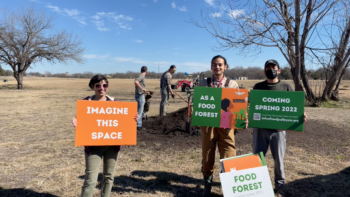
During the planning phase of the food forest, organizers placed signs around the city with a QR code link to an anonymous survey where people could input ideas about what kinds of plants and other features they wanted to see in the food forest. Photo: Katherine Favor, NCAT
Padre Park was an underutilized county park in a neighborhood in Southside San Antonio that had one of the lowest tree equity scores within San Antonio. The neighborhood was also classified as a food desert, an area where residents have little access to affordable and nutritious food. The Food Policy Council of San Antonio, a volunteer-based nonprofit, came together to brainstorm solutions, and they determined that planting a food forest was one solution that could address the issues of both food insecurity and tree inequity. They formed an Executive Committee composed of diverse stakeholders, and together they pitched their idea of a public food forest at Padre Park to the City of San Antonio and Bexar County. Bexar County agreed to donate their park land to the project, and the City of San Antonio’s Parks and Recreation Department, Office of Innovation, and Metropolitan Health District provided access to city water, irrigation infrastructure, planning guidance, and other resources. Numerous different local groups also pitched in to support the project. A local nonprofit called Bexar Branches provided free tree saplings and planting expertise, the Texas Wine Alliance supplied money for benches and bike racks, private donors provided funds for architects to design the space, and dozens of volunteers from the community donated their time and energy to plant the food forest. Thanks to all this support, the food forest stewards finally broke ground in February 2022, and dozens of trees were planted.
While the food forest is still young, San Antonio residents are excited to watch it grow. One of the things that community members expressed the most excitement about is getting to share the food forest with younger generations, and teaching them how to keep their bodies, communities, and the earth healthy by growing food in a sustainable way. “We as a society have gotten away from what our natural teachings are, but we can come back,” says local resident and Coahuilteco descendant Lotus Rios. “In our modern society we lost so much. But now I get to watch my little boys create a food forest. My children get to see that there’s a better way.”

Volunteers plant native pecan trees at the Tamōx Talōm Food Forest. Photo: NCAT
Deciding what kinds of trees and plants to include in the food forest was a group effort that involved the input of all the stakeholders within the public-private partnership, as well as members of surrounding neighborhoods. Native plants well adapted to San Antonio’s climate of both extreme heat and extreme cold temperatures were prioritized in the planning process, with special emphasis on making sure the selected plants were useful and desirable to community members. Community organizers went door-to-door, held potlucks and gatherings, and posted signs throughout the city with a QR code link to a survey, to gather input from as many people as possible on what species to plant. The resulting species list is reflective of what grows well in San Antonio, what supports local wildlife, and what is culturally significant to community members themselves. And, of course, priority was given to perennial plants. “There’s an important distinction in gardening and farming between annual and perennial plants,” explains Mitch Hagney, one of the Executive Committee members for the food forest. “Planting something as a perennial is an investment in the future. Having the city and the community come out to plant perennial agriculture means something very specific: it means we’re not going anywhere, and we want this place to thrive. It means we want everyone to be fed for the years to come.”
What’s Growing?
Overstory Tree Layer: red mulberry (Morus rubra), carob (Ceratonia siliqua), hardy native pecan (Carya illinoinensis), loquat (Eriobotrya japonica), ‘Fuyu’ persimmon (Diospyros kaki), Anacua (Ehretia anacua), burr oak (Quercus macrocarpa), catalpa (Catalpa speciosa), chinquapin oak (Quercus muehlenbergii), hawthorn (Crataegus monogyna), Texas Hercules’ club (Zanthoxylum hirsutum), Mexican white oak (Quercus polymorpha), slippery elm (Ulmus rubra), Texas ebony (Ebenopsis ebano), ‘Reda’ Persian walnut (Juglans regia), black walnut (Juglans nigra), Western soapberry (Sapindus saponaria var. drummondii)
Understory Tree Layer: ‘Dorsett Gold’ apple (Malus domestica), native Texas persimmon (Diospyros texana), honey mesquite (Prosopis glandulosa), ‘Ayers’ pear (Pyrus communis), ‘Methley’ plum (Prunus salicina), Mexican plum (Prunus mexicana), ‘Texas Pink’ pomegranate (Punica granatum), satsuma mandarin (Citrus unshiu), ‘Rio Red’ grapefruit (Citrus paradisi Macfadyen), ‘Alma’ fig (Ficus carica), olive (Olea europaea), ‘Red Haven’ peach (Prunus persica), American witch hazel (Hamamelis virginiana L.), Mexican elderberry (Sambucus nigra), moringa (Moringa oleifera), pawpaw (Asimina triloba), filbert (Corylus maxima)
Shrub Layer: nopal (Opuntia ficus-indica), agarita (Mahonia trifoliolata), Mojave yucca (Yucca schidigera), rosemary (Salvia rosmarinus), lavender (Lavandula angustifolia), goji berry (Lycium barbarum), aronia (Aronia melanocarpa), gooseberry (Ribes uva-crispa)
Herbaceous Crop Layer: Chile pequín (Capsicum annuum ‘Pequin’), zucchini (Cucurbita pepo), ‘Texas Gourdseed’ corn (Zea mays), ‘Slo Bolt’ cilantro (Coriandrum sativum), kale (Brassica oleracea), ‘Crawford bibb’ lettuce (Lactuca sativa), ‘Hopi Red Dye’ amaranth (Amaranthus cruentus), lemon balm (Melissa officinalis), rhubarb (Rheum rhabarbarum), ‘Jersey Supreme’ asparagus (Asparagus officinalis), ‘Green Globe’ artichoke (Cynara cardunculus), basil (Ocimum basilicum), echinacea (Echinacea angustifolia), mugwort (Artemisia vulgaris), broccoli (Brassica oleracea var. Italica), cauliflower (Brassica oleracea var. Botrytis), cabbage (Brassica oleracea var. Capitata), celery (Apium graveolens), Swiss chard (Beta vulgaris L.), collards (Brassica oleracea var. Acephala), spinach (Spinacia oleracea)
Groundcover Layer: stinging nettle (Urtica dioica), Spearmint (Mentha spicata), ‘Marketmore’ cucumber (Cucumis sativus L.), common purslane (Portulaca oleracea), alpine strawberry (Fragaria vesca), sorrel (Rumex acetosa), nasturtium (Tropaeolum majus), lemongrass (Cymbopogon citratus), chamomile (Matricaria chamomilla), creeping St. John’s wort (Hypericum calycinum)
Root Crop Layer: garlic (Allium sativum), onion (Allium cepa), potato (Solanum tuberosum), horseradish (Armoracia rusticana), beet (Beta vulgaris), carrot (Daucus carota), turnip (Brassica rapa), radish (Raphanus sativus)
Vine Crop Layer: maypop (Passiflora incarnata), muscadine grape (Vitis rotundifolia), chayote (Sechium edule), golden kiwifruit (Actinidia chinensis), pole bean (Phaseolus vulgaris), scarlet runner bean (Phaseolus coccineus), ‘Sun Gold’ tomato (Lycopersicon esculentum), birdhouse gourd (Lagenaria siceraria), black-eyed Susan vine (Thunbergia alata)
Forest Gardens in the Pacific Northwest
Beacon Food Forest, Seattle, Washington
USDA Plant Hardiness Zone 8b
Located in Seattle, Washington, Beacon Food Forest is a 7-acre forest garden that stands as a pioneering model for food forests across the country. Founded in 2009, it was one of the first public food forests in the United States, born out of the dream of four local residents who had taken a permaculture design course and who were eager to put the concepts they had learned into action. They presented the idea of a food forest to the City of Seattle, and, after months of negotiations, they were awarded the rights of use to two parcels owned by Seattle Public Utilities in exchange for paying a minimal amount of rent. The support and enthusiasm from community members in the area was overwhelming, and for many months the community gathered regularly for visioning and planning sessions to design what they wanted to see in their food forest. Through their collective effort, and through funding from a $22,000 Small and Simple grant from Seattle Department of Neighborhoods, the design of the Beacon Food Forest gradually took shape. To implement their vision, community members needed to partner with an umbrella organization that could provide stability, resources, insurance, and a legal structure through which they could continue to do business. The group decided to partner with the Seattle Department of Neighborhoods as its umbrella organization and became recognized as an official community garden in the City’s P-Patch Community Gardening Program. In 2012, Beacon Food Forest planted its first trees.
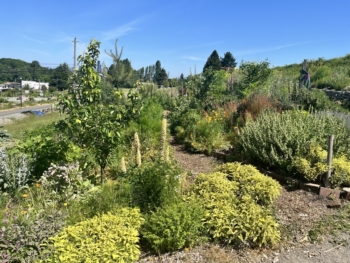
An apple tree guild with an understory of mint, rosemary, fennel, horsetail, lambsquarters, and more. Photo: Katherine Favor, NCAT
In the years since, Beacon Food Forest has grown into an abundant garden that has inspired a movement of other food forest initiatives around the country. Today, the site boasts a composting space, an herb spiral, a mushroom and hops hut, a gathering plaza where events are hosted, a garden where food is produced for the local Rainier Valley Food Bank, and a public forest garden called “Common Thread” that is always open to the public for free harvesting. As visitors meander through a labyrinth of winding paths, they are invited to harvest, rest, and interact with the land. “Earth care, people care, fair share” is a permaculture-inspired motto that the food forest strives to embody and, while the majority of the food forest produces food for people, there are also sections of the site dedicated to pollinator habitat and native plant guilds, to support the surrounding ecosystem.
Beacon Food Forest continues to be a volunteer-based project sustained by grants, donations, volunteer contributions, and continued support from the City of Seattle’s Department of Neighborhoods. Maintenance of most of the food forest is done by a team of more than 50 volunteers who have the option to either join large work parties every third Saturday of the month, or who can drop in on their own time to weekly “mini work parties.” There are also committees of more committed “core volunteers,” who work together to manage often-complicated tasks such as grant writing, fundraising, community development, and educational activities, among others. Other resources, like irrigation infrastructure, water, and maintenance of some of the community garden beds, come from Seattle’s Department of Neighborhoods.
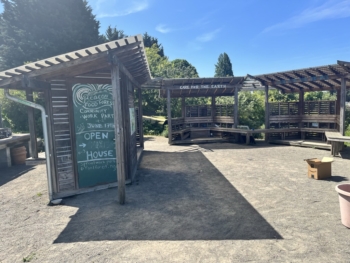
The commons area where volunteers gather and events are hosted. Photo: Katherine Favor, NCAT
The overarching vision of the Beacon Food Forest is to create “a world where every community participates in creating local food ecosystems.” As such, education is a core objective of the food forest, and in addition to hosting volunteer days, it also offers educational events such as harvest celebrations, garden tasting tours, festivals with live music, summer camps for kids, field trips with local schools, permaculture-related workshops for adults, food justice classes, and more. Beacon Food Forest also has educational signs throughout that teach about ecological design and ethical harvest: the concept of harvesting in a way that ensures the equitable distribution of the food while also maintaining the vitality of the ecosystem itself.

An apple tree guild with an understory of mint, rosemary, fennel, horsetail, lambsquarters, and more. Photo: Katherine Favor, NCAT
What’s Growing?
Overstory Tree Layer: American butternut (Juglans cinerea), Japanese walnut (Juglans ailantifolia), loquat (Eriobotrya japonica), Western crabapple (Malus fusca), ‘Precoce Migoule’ hybrid chestnut (Castanea sativa x crenata), ‘Sweet Lavender’ mulberry (Morus alba)
Understory Tree Layer: ‘Desert King’ fig (Ficus carica), ‘Smyrna’ quince (Cydonia oblonga), ‘Parfianka’ pomegranate (Punica granatum), ‘Enterprise’ apple (Malus domestica), ‘Jonagold’ apple (Malus domestica), black elderberry (Sambucus nigra), American hazelnut (Corylus americana), ‘Shiro’ plum (Prunus salicina), ‘El Dorado’ peach (Prunus persica), Maqui Chilean wineberry (Aristotelia chilensis), common medlar (Mespilus germanica)
Shrub Layer: Apache blackberry (Rubus canadensis), American gooseberry (Ribes hirtellum), red currant (Ribes sanguineum), white currant (Ribes rubrum var. alba), ‘Cascade gold’ raspberry (Rubus idaeus L.), goumi (Elaeagnus multiflora), chokeberry (Aronia melanocarpa), goji berry (Lycium barbarum L.), rosemary (Rosmarinus officinalis), pink champagne blueberry (Vaccinium corymbosum L.), Oregon grape (Mahonia aquifolium), blue honeysuckle (Lonicera caerulea), Himalaya honeysuckle (Leycesteria formosa), thimbleberry (Rubus parviflorus Nutt.), tea tree (Melaleuca alternifolia), salal (Gaultheria shallon), Highbush blueberry (Vaccinium corymbosum), thin-leaved huckleberry (Vaccinium membranaceum), salmonberry (Rubus spectabilis), Western serviceberry (Amelanchier alnifolia)
Herbaceous Crop Layer: Romaine lettuce (Lactuca sativa. var. longifolia), sorrel (Rumex acetosa), chives (Allium schoenoprasum), artichoke (Cynara cardunculus var. scolymus), costus (Dolomiaea costus), palmarosa (Cymbopogon martinii), lemongrass (Cymbopogon citratus), Aztec sweet herb (Phyla dulcis), kale (Brassica oleracea), lupine (Lupinus perennis), echinacea (Echinacea purpurea), zucchini (Cucurbita pepo), fava bean (Vicia faba), Swiss chard (Beta vulgaris subsp. Vulgaris), amaranth (Amaranthus palmeri), safflower (Carthamus tinctorius L.), asparagus (Asparagus officinalis), ‘Blue Pagoda’ honeyberry (Lonicera caerulea), elecampane (Inula helenium), yarrow (Achillea millefolium), ‘Small Sugar’ pumpkin (Cucurbita pepo), horehound (Marrubium vulgare), giant butterbur (Petasites japonicus), arugula (Eruca sativa), orache (Atriplex hortensis), borage (Borago officinalis), tomatillo (Physalis philadelphica), common tule (Schoenoplectus acutus), lovage (Levisticum officinale), motherwort (Leonurus cardiaca)
Groundcover Layer: ‘Alpine’ strawberry (Fragaria vesca), nasturtium (Tropaeolum majus), spearmint (Mentha spicata), cucumber (Cucumis sativus L.), ground cherry (Physalis peruviana), sedum (Sedum ternatum), chickweed (Stellaria media), miner’s lettuce (Claytonia perfoliata)
Root Crop Layer: Daikon radish (Raphanus sativus var. Longipinnatus), onion (Allium cepa), garlic (Allium sativum), Jerusalem artichoke (Helianthus tuberosus), camas root (Camassia quamash)
Vine Crop Layer: sugar snap pea (Pisum sativum), hops (Humulus lupulus), ‘San Marzano’ tomato (Solanum lycopersicum), hardy kiwi (Actinidia arguta), Mexican sour gherkin (Melothria scabra), Concord grape (Vitis labrusca)
Fungal Layer: oyster mushrooms (Pleurotus ostreatus)
Forest Gardens in California
Coastal Roots Farm, Encinitas, California
USDA Plant Hardiness Zone 10
Sitting atop a hill overlooking San Diego’s coastline, Coastal Roots Farm is a nonprofit community farm and education center dedicated to growing healthy communities and healthy food. Founded in 2014, Coastal Roots Farm originally began as a project funded by the philanthropic organization The Leichtag Foundation, before becoming its own 501(c)(3) nonprofit in 2015. Its farming practices are inspired by ancient Jewish wisdom, rooted in the belief that regenerative agriculture holds the key to a healthy planet, healthy people, and healthy communities.

A chicken silvopasture system, in which chickens are rotated through alleys of elderberry and pomegranate trees. Photo: Katherine Favor, NCAT
Of Coastal Roots Farm’s 17 total acres, eight acres are planted to agroforestry practices, with four acres devoted exclusively to its food forest and another four dedicated to its alley cropping and rotational pastured poultry silvopasture system. The food forest is teeming with life, with seven vertical layers of vegetation, more than 60 varieties of plants, and more than 1,400 plants in total. San Diego’s warm Mediterranean climate, classified as USDA Plant Hardiness Zone 10, can support a wide variety of trees and crops —from subtropical plants to cool-climate plants to desert plants. Because of this, Coastal Roots Farm has designed the food forest with different plant “guilds,” or communities of plants, each organized by climate zone. There is a desert zone, with California natives and other drought-tolerant plants such as oak, elderberry, coyote brush, white sage, black sage, artemisia, nopal, lavender, and nettles. Just around the corner is the Mediterranean zone, with plants such as apples, apricots, dates, figs, nectarines, olives, pomegranates, strawberries, and tomatoes. There is even a subtropical zone with banana, pineapple guava, sapote, Kei apple, pineapple, cassava, ginger, and turmeric. Although all these zones are planted relatively near to one another, their irrigation schedules vary significantly. Simple adjustments to the amount of water that each zone receives through drip irrigation allows a rich diversity of plants to be grown here.

Photo: Katherine Favor, NCAT
While the goal of Coastal Roots Farm’s food forest is to produce a wide variety of food for community foraging purposes, the alley cropping and silvopasture system is focused on maximizing production. Pomegranates, figs, elderberries, and several nitrogen-fixing trees like Leucaena leucocephala and Paraserianthes lophantha are planted in rows on contour with the slope of the land, and in the alleyways between the trees a wide variety of vegetables grows. At the end of the growing season, after the vegetables are harvested, chickens are rotated into the space with a mobile chicken tractor. The chickens produce a harvest of eggs while also preparing the vegetable beds for the next season of planting. They eat whatever vegetable refuse is remaining, consume pests and pest eggs that may have remained on the previous season’s crop, fertilize the soil with their manure, and shallowly till the soil so that it is ready for the next cycle of planting. Next, cover crops like vetch, mustard, brome, and winter clover are planted into the soil, and after three months, those cover crops are mowed and the next season’s vegetables are planted directly into the cover crop residue.
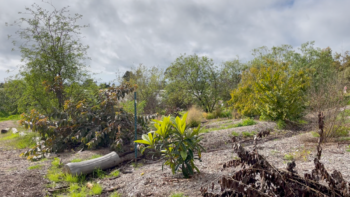
Photo: Katherine Favor, NCAT
By maximizing vertical space through its multiple layers, this alley cropping/silvopasture system is able to produce approximately 37,000 pounds of food annually. As a nonprofit farm, Coastal Roots Farm’s marketing practices are centered around an ethic of food justice, and more than 70% of this produce is either donated to underserved members of the community or sold at a “pay-what-you-can” farmstand, which offers customers access to fresh produce with the flexibility to pay an amount that aligns with their financial means.
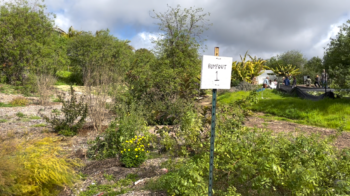
Photo: Katherine Favor, NCAT
Community education and engagement is part of Coastal Roots Farm’s mission, so it hosts a variety of community events that bring people together to foster connections with each other and the land. Interactive tours, foraging workshops, weekly volunteer days, an internship program, farm camps, and an annual Food Forest Festival to commemorate the Jewish holiday of Tu’B Shvat are just a few of its community offerings. Gatherings like these foster a sense of belonging and inspire a collective commitment to sustainable living.
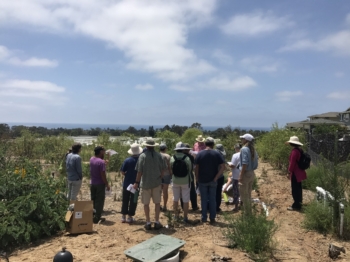
Photo: Katherine Favor, NCAT
Both people and wildlife call the Coastal Roots Farm food forest home. For more than five years, local birdwatchers came to Coastal Roots Farm to conduct monthly bird-counting surveys, and they documented more than 90 species of birds living in the food forest. These included the Coastal California Gnatcatcher (Polioptila californica californica), a federally threatened bird, along with other rare species such as the California Towhee (Melozone crissalis), the Blue-Gray Gnatcatcher (Polioptila caerulea), the Black Phoebe (Sayornis nigricans), Say’s Phoebe (Sayornis saya), Anna’s Hummingbird (Calypte anna), Cooper’s Hawk (Accipeter cooperii), and dozens of others. Of the 96 bird species documented, 21 were confirmed to use the food forest as their breeding site (Smith, 2023).
What’s Growing?
Overstory Tree Layer: white sapote (Casimiroa edulis), white mulberry (Morus alba), ‘Jiro Fuyu’ persimmon (Diospyros kaki), loquat (Eriobotrya japonica), ‘Hass’ avocado (Persea americana), carob (Ceratonia siliqua), date palm (Phoenix dactylifera), ice cream bean (Inga edulis), stink bean (Paraserianthes lophantha)
Understory Tree Layer: Mexican elderberry (Sambucus mexicana), silver wattle (Acacia dealbata), pineapple guava (Acca sellowiana), pomegranate (Punica granatum), kei apple (Dovyalis caffra), common fig (Ficus carica), Chilean mesquite (Prosopis chilensis), leadtree (Leucaena leucocephala), ‘Anna’ apple (Malus domestica), ‘Lady Finger’ banana (Musa acuminata), ‘Spice Zee’ nectaplum (Prunus salicina x Prunus armeniaca x Prunus persica), ‘Tropic Gold’ apricot (Prunus armeniaca), Suriname cherry (Eugenia uniflora)
Shrub Layer: California sagebrush (Artemesia californica), manzanita (Arctostaphylos manzanita), coyote brush (Baccharis pilularis), California lilac (Ceanothus griseus horizontalis), Oregon grape (Mahonia aquifolium), golden currant (Ribes aureum), nopal (Opuntia fragilis), ‘Rebel’ blueberry (Vaccinium sp. Hybrid), hollyleaf cherry (Prunus ilicifolia), sugar sumac (Rhus ovata), lavender (Lavandula angustifolia), California buckwheat (Eriogonum fasciculatum)
Herbaceous Crop Layer: cassava (Manihot esculenta), ‘Sugar Pie’ pumpkin (Cucurbita pepo), zucchini (Cucurbita pepo), broccoli (Brassica oleracea), asparagus (Asparagus officinalis), yarrow (Achillea millefolium), comfrey (Symphytum), white sage (Salvia apiana)
Groundcover Layer: stinging nettle (Urtica dioica), mint (Mentha piperita L.), strawberry (Fragaria x ananassa), oregano (Origanum vulgare), nasturtium (Tropaeolum majus)
Root Crop Layer: garlic (Allium sativum), onion (Allium cepa), beet (Beta vulgaris subsp. vulgaris), potato (Solanum tuberosum), ginger (Zingiber officinale), turmeric (Curcuma longa)
Vine Crop Layer: passion fruit (Passiflora edulis), California wild grape (Vitis californica), ‘Viognier’ (Vitis vinifera ‘Viognier’), dragon fruit (Hylocereus spp.), kiwi (Actinidia deliciosa)
References
Armstrong, C.G., J. Earnshaw, and A.C. McAlvay. 2022. Coupled archaeological and ecological analyses reveal ancient cultivation and land use in Nuchatlaht (Nuu-chah-nulth) territories, Pacific Northwest. Journal of Archaeological Science. Vol. 143. p. 105611.
Smith, S. 2023. Bird Trends in the Food Forest. 2017-2022 Final Report. Coastal Roots Farm, Encinitas, CA.
Further Resources
ATTRA Resources
Agroforestry: An Overview
This publication offers an introduction to the concept of agroforestry and its key practices: alley cropping, silvopasture, windbreaks, forest farming, and riparian buffer strips.
Community Gardening
A publication intended for organizations supporting community-gardening development, with information on starting community gardens and resources for establishing and managing them.
Community Supported Agriculture
A publication on the Community Supported Agriculture (CSA) model of selling produce, which connects people with where their food comes from by encouraging customers to become shareholders in the farm business.
Episode 240. Urban Agroforestry for Dryland Environments
A podcast episode from Voices from the Field, in which NCAT Agriculture Specialist Katherine Favor talks with Christopher Marciello of Ecology Artisans — a regenerative landscape and design firm — about urban agroforestry in dryland environments.
Forest Gardens Technical Guide (coming soon)
A technical guide for designing forest gardens/food forests, with information on planning, ecological design, management and maintenance, social considerations, and case studies.
Regenerating Damaged Soils on an Urban Farm
A video demonstrating how Garcia Street Farm, an urban farm in San Antonio, Texas, is contending with issues such as compacted soil, debris, low organic matter, stubborn grass weeds from surrounding lawns, and lack of biodiversity for insect control.
Start a Farm in the City
A guide to starting a farm in the city.
Urban Agroforestry
Describes how, with proper planning, design, and management, integration of trees and other perennial crops into urban, suburban, and other community spaces can increase the economic, ecological, and community resilience of urban areas.
Urban Agroforestry Case Study: Utilizing Agroforestry in Floodplain Restoration Projects
The story of how the City of Austin, Texas, is using urban agroforestry to restore floodplain buyout land that previously had residential housing on it.
Urban Agroforestry Case Study: Starting a Food Forest on Public Park Land
Festival Beach Food Forest’s story of starting a community food forest on public park land in Austin, Texas.
Urban Agroforestry Tipsheet: Food Forests and Beyond
Information about agroforestry in urban areas, including tips for how to plan, design, establish, and maintain urban agroforestry systems.
Other Resources
Association of Nature and Forest Therapy (ANFT)
One of the leaders in promoting the development and practice of Forest Therapy, a program that draws on the latest medical research, new developments in the field of nature connection, and ancient traditions.
Bloomington Community Orchard
An all-volunteer 501(c)(3) nonprofit that provides free produce to the community, education, and experience-sharing.
Building Our Future: A Guide to Community Visioning. 2000. By Gary Green, Anna Haines, and Stephen Halebsky. Cooperative Extension of the University of Wisconsin–Extension.
A manual that provides community residents with a process for thinking about and planning for their mutual future.
The Center for Agroforestry at the University of Missouri
The Center for Agroforestry is one of the world’s leading centers contributing to the science of agroforestry. The Center’s long-term research, teaching, and technology-transfer efforts help make a better world by discovering, integrating, and applying new agroforestry knowledge, and by educating and training students, professionals, scientists, leaders, and the general public.
Community Food Forests
An interactive map of community food forest initiatives across the United States.
The Community Food Forest Handbook. 2018. By Catherine Bukowski and John Munsell. Chelsea Green Publishing, LLC. White River Junction, VT.
A book about the civic aspects of community food forests, with ideas for building and sustaining momentum, working with diverse stakeholders, integrating assorted civic interests and visions within a project, creating safe and attractive sites, navigating community policies, and more.
Creating a Forest Garden—Working with Nature to Grow Edible Crops. 2010. By Martin Crawford. Green Books, UK.
Information on forest gardens, including planning, design, planting, and maintenance, as well as a detailed directory of more than 500 edible plants.
Edible Forest Gardens, Vol. 1. 2005. By Dave Jacke and Eric Toensmeier. Ecological Vision and Theory for Temperate Climate Permaculture. Chelsea Green Publishing Co., White River Junction, VT.
Introduces historic and visionary bases of edible forest gardens. Describes ecological relationships, structures, and succession.
Edible Forest Gardens, Vol. 2. 2005. By Dave Jacke and Eric Toensmeier. Ecological Design and Practice for Temperate Climate Permaculture. Chelsea Green Publishing Co., White River Junction, VT.
Details the design process, site preparation and establishment, and maintenance of the edible forest garden.
Forest Gardening: Cultivating an Edible Landscape, 2nd Edition. 1996. By Robert Hart. Chelsea Green Publishing, White River Junction, VT.
Describes how to transform even a small cottage garden into a hospitable diverse habitat for songbirds, butterflies, and other wildlife by using a wide variety of useful plants.
Gaia’s Garden: A Guide to Home-Scale Permaculture, 2nd Edition. 2009. By Toby Hemenway. Chelsea Green Publishing, White River Junction, VT.
A guide to creating a backyard ecosystem by assembling communities of plants that can work cooperatively, with a chapter on urban permaculture.
The Giving Grove
A nonprofit that supports a nationwide network of over 400 small community orchards and food forests. Provides free design, planning, mentoring, training, and seed funding to start and support community orchard projects all over the United States.
Resources for Working with Communities. 2020. By Catherine Bukowski.
Resources for creating systems of governance and decision making, leading productive meetings, community visioning, and more.
USDA NRCS PLANTS Database
An extensive plant database to determine species for agroforestry operations based on different criteria.
Community Forest Gardens: Case Studies Throughout the United States
By Katherine Favor, NCAT Agroforestry Specialist
Published September 2023
© NCAT
IP651
This publication is produced by the National Center for Appropriate Technology through the ATTRA Sustainable Agriculture program, under a cooperative agreement with USDA Rural Development. This publication was also made possible in part by a cooperative agreement with the United States Botanic Garden, and by a grant from the U.S. Department of Agriculture (USDA), Forest Service, National Agroforestry Center, under the authority of the Cooperative Forestry Assistance Act of 1978. These institutions are equal opportunity providers, employers, and lenders. ATTRA.NCAT.ORG.



